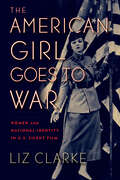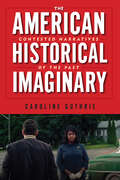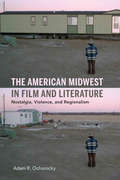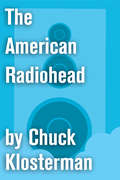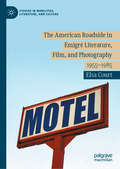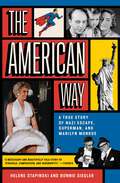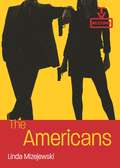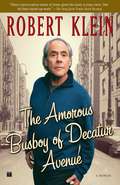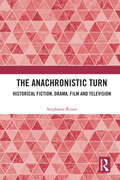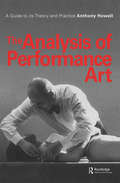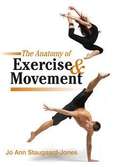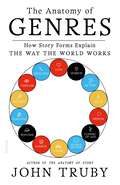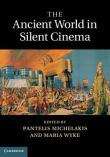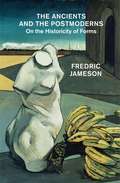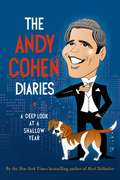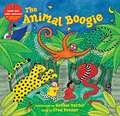- Table View
- List View
The American City in the Cinema
by James A. ClappThe American city and the American movie industry grew up together in the early decades of the twentieth century, making film an ideal medium through which to better understand urban life. Exploiting the increasing popularity of large metropolitan cities and urban lifestyle, movies chronicled the city and the stories it generated. In this volume, urbanist James A. Clapp explores the reciprocal relationship between the city and the cinema within the dimensions of time and space.A variety of themes and actualizations have been repeated throughout the history of the cinema, including the roles of immigrants, women, small towns, family farms, and suburbia; and urban childhoods, family values, violent crime, politics, and dystopic futures. Clapp examines the different ways in which the city has been characterized as well as how it has been portrayed as a character itself.Some of the films discussed include Metropolis, King Kong, West Side Story, It's a Wonderful Life, American Beauty, Rebel without a Cause, American Graffiti, Blade Runner, Gangs of New York, The Untouchables, LA Confidential, Sunrise, Crash, American History X, Breakfast at Tiffany's, The Deer Hunter, and many more. This work will be enjoyed by urban specialists, moviegoers, and those interested in American, cultural, and film studies.
The American Girl Goes to War: Women and National Identity in U.S. Silent Film (War Culture)
by Liz ClarkeDuring the 1910s, films about war often featured a female protagonist. The films portrayed women as spies, cross-dressing soldiers, and athletic defenders of their homes—roles typically reserved for men and that contradicted gendered-expectations of home-front women waiting for their husbands, sons, and brothers to return from battle. The representation of American martial spirit—particularly in the form of heroines—has a rich history in film in the years just prior to the American entry into World War I. The American Girl Goes to War demonstrates the predominance of heroic female characters in in early narrative films about war from 1908 to 1919. American Girls were filled with the military spirit of their forefathers and became one of the major ways that American women’s changing political involvement, independence, and active natures were contained by and subsumed into pre-existing American ideologies.
The American Historical Imaginary: Contested Narratives of the Past
by Caroline GuthrieIn The American Historical Imaginary: Contested Narratives of the Past in Mass Culture Caroline Guthrie examines the American relationship to versions of the past that are known to be untrue and asks why do these myths persist, and why do so many people hold them so dear? To answer these questions, she examines popular sites where fictional versions of history are formed, played through, and solidified. From television’s reality show winners and time travelers, to the Magic Kingdom in Walt Disney World, to the movies of Quentin Tarantino, this book examines how mass culture imagines and reimagines the most controversial and painful parts of American history. In doing so, Guthrie explores how contemporary ideas of national identity are tied to particular versions of history that valorize white masculinity and ignores oppression and resistance. Through her explanation and analysis of what she calls the historical imaginary, Guthrie offers new ways of attempting to combat harmful myths of the past through the imaginative engagements they have dominated for so long.
The American Jewish Story Through Cinema (Jewish Life, History, and Culture)
by Eric A. GoldmanLike the haggadah, the traditional “telling” of the story of the Israelites’ exodus from Egypt that is read at the Passover seder, cinema offers a valuable text from which to gain an understanding of the social, political, and cultural realities of Jews in America. In an industry strongly influenced by Jewish filmmakers who made and continue to make the decisions as to which films are produced, the complex and evolving nature of the American Jewish condition has had considerable impact on American cinema and, in particular, on how Jews are reflected on the screen. This groundbreaking study analyzes select mainstream films from the beginning of the sound era to today to provide an understanding of the American Jewish experience over the last century. In the first half of the twentieth century, Hollywood’s movie moguls, most of whom were Jewish, shied away from asserting a Jewish image on the screen for fear that they might be too closely identified with that representation. Over the next two decades, Jewish moviemakers became more comfortable with the concept of a Jewish hero and with an overpowered, yet heroic, Israel. In time, the Holocaust assumed center stage as the single event with the greatest effect on American Jewish identity. Recently, as American Jewish screenwriters, directors, and producers have become increasingly comfortable with their heritage, we are seeing an unprecedented number of movies that spotlight Jewish protagonists, experiences, and challenges.
The American Jewish Story through Cinema (Jewish Life, History, and Culture)
by Eric A. GoldmanLike the haggadah, the traditional “telling” of the story of the Israelites’ exodus from Egypt that is read at the Passover seder, cinema offers a valuable text from which to gain an understanding of the social, political, and cultural realities of Jews in America. In an industry strongly influenced by Jewish filmmakers who made and continue to make the decisions as to which films are produced, the complex and evolving nature of the American Jewish condition has had considerable impact on American cinema and, in particular, on how Jews are reflected on the screen. This groundbreaking study analyzes select mainstream films from the beginning of the sound era to today to provide an understanding of the American Jewish experience over the last century. In the first half of the twentieth century, Hollywood’s movie moguls, most of whom were Jewish, shied away from asserting a Jewish image on the screen for fear that they might be too closely identified with that representation. Over the next two decades, Jewish moviemakers became more comfortable with the concept of a Jewish hero and with an overpowered, yet heroic, Israel. In time, the Holocaust assumed center stage as the single event with the greatest effect on American Jewish identity. Recently, as American Jewish screenwriters, directors, and producers have become increasingly comfortable with their heritage, we are seeing an unprecedented number of movies that spotlight Jewish protagonists, experiences, and challenges.
The American Midwest in Film and Literature: Nostalgia, Violence, and Regionalism
by Adam R. OchonickyHow do works from film and literature—Sister Carrie, Native Son, Meet Me in St. Louis, Halloween, and A History of Violence, for example—imagine, reify, and reproduce Midwestern identity? And what are the repercussions of such regional narratives and images circulating in American culture? In The American Midwest in Film and Literature: Nostalgia, Violence, and Regionalism, Adam R. Ochonicky provides a critical overview of the evolution, contestation, and fragmentation of the Midwest's symbolic and often contradictory meanings. Using the frontier writings of Frederick Jackson Turner as a starting point, this book establishes a succession of Midwestern filmic and literary texts stretching from the late-19th century through the beginning of the 21st century and argues that the manifold properties of nostalgia have continually transformed popular understandings and ideological uses of the Midwest's place-identity. Ochonicky identifies three primary modes of nostalgia at play across a set of textual objects: the projection of nostalgia onto physical landscapes and into the cultural sphere (nostalgic spatiality); nostalgia as a cultural force that regulates behaviors, identities, and appearances (nostalgic violence); and the progressive potential of nostalgia to generate an acknowledgment and possible rectification of ways in which the flawed past negatively affects the present (nostalgic atonement). While developing these new conceptions of nostalgia, Ochonicky reveals how an under-examined area of regional study has received critical attention throughout the histories of American film and literature, as well as in related materials and discourses. From the closing of the Western frontier to the polarized political and cultural climate of the 21st century, this book demonstrates how film and literature have been and continue to be vital forums for illuminating the complex interplay of regionalism and nostalgia.
The American Midwest in Film and Literature: Nostalgia, Violence, and Regionalism
by Adam R. OchonickyA critical overview of the evolution, contestation, and fragmentation of the Midwest’s symbolic (and often contradictory) meanings in American culture.How do works from film and literature—Sister Carrie, Native Son, Meet Me in St. Louis, Halloween, and A History of Violence, for example—imagine, reify, and reproduce Midwestern identity? And what are the repercussions of such regional narratives and images circulating in American culture? In The American Midwest in Film and Literature: Nostalgia, Violence, and Regionalism, Adam R. Ochonicky provides a critical overview of the evolution, contestation, and fragmentation of the Midwest’s symbolic and often contradictory meanings.Using the frontier writings of Frederick Jackson Turner as a starting point, this book establishes a succession of Midwestern filmic and literary texts stretching from the late-19th century through the beginning of the 21st century and argues that the manifold properties of nostalgia have continually transformed popular understandings and ideological uses of the Midwest’s place-identity. Ochonicky identifies three primary modes of nostalgia at play across a set of textual objects: the projection of nostalgia onto physical landscapes and into the cultural sphere (nostalgic spatiality); nostalgia as a cultural force that regulates behaviors, identities, and appearances (nostalgic violence); and the progressive potential of nostalgia to generate an acknowledgment and possible rectification of ways in which the flawed past negatively affects the present (nostalgic atonement). While developing these new conceptions of nostalgia, Ochonicky reveals how an under-examined area of regional study has received critical attention throughout the histories of American film and literature, as well as in related materials and discourses. From the closing of the Western frontier to the polarized political and cultural climate of the 21st century, this book demonstrates how film and literature have been and continue to be vital forums for illuminating the complex interplay of regionalism and nostalgia.“Ochonicky presents an important reading of how nostalgia shapes the Midwest in the American imagination as a place of identity and violence. Past and present slip in this compelling and well-researched approach to the workings of contemporary culture.” —Vera Dika, author of Recycled Culture in Contemporary Art and Film: The Use of Nostalgia“By centering the concept of region, Adam Ochonicky provides an insightful and refreshing reading of American popular culture. In texts ranging from Richard Wright’s Native Son to John Carpenter’s Halloween, Ochonicky demonstrates the complex terrain of the Midwest in our cultural imaginary and the diverse memories and meanings we project upon it.” —Kendall R. Phillips, author of A Place of Darkness: The Rhetoric of Horror in Early American Cinema, Syracuse University
The American Musical: Evolution of an Art Form
by Ben WestThe American Musical is a comprehensive history of an American art form. It delivers a detailed and definitive portrait of the American musical’s artistic evolution over the course of seven distinct, newly defined eras, with a unique perspective gleaned from research at more than twenty different archives across the United States.Individual in both its approach and coverage, The American Musical traces the form’s creative journey from its 19th century beginnings, through its 20th century maturation, and to the turn of the 21st century, shedding new light on a myriad of authors, directors, and craftspeople who worked on Broadway and beyond. This book actively addresses the form’s often overlooked female and African-American artists, provides an in-depth accounting of such outside influences as minstrelsy, vaudeville, nightclubs, and burlesque, and explores the dynamic relationship between the form and the consciousness of its country.The American Musical is a fascinating and insightful read for students, artists, and afficionados of the American musical, and anyone with an interest in this singular form of entertainment.
The American Orchestra and Theodore Thomas
by Charles Edward RussellThe history of the American orchestra.<P><P> Pulitzer Prize Winner
The American Radiohead
by Chuck KlostermanOriginally collected in Chuck Klosterman IV and now available both as a stand-alone essay and in the ebook collection Chuck Klosterman on Pop, this essay is about Jeff Tweedy.
The American Roadside in Émigré Literature, Film, and Photography: 1955–1985 (Studies in Mobilities, Literature, and Culture)
by Elsa CourtThe American Roadside in Émigré Literature, Film, and Photography: 1955–1985 traces the origin of a postmodern iconography of mobile consumption equating roadside America with an authentic experience of the United States through the postwar road narrative, a narrative which, Elsa Court argues, has been shaped by and through white male émigré narratives of the American road, in both literature and visual culture. While stressing that these narratives are limited in their understanding of the processes of exclusion and unequal flux in experiences of modern automobility, the book works through four case studies in the American works of European-born authors Vladimir Nabokov, Robert Frank, Alfred Hitchcock, and Wim Wenders to unveil an early phenomenology of the postwar American highway, one that anticipates the works of late-twentieth-century spatial theorists Jean Baudrillard, Michel Foucault, and Marc Augé and sketches a postmodern aesthetic of western mobility and consumption that has become synonymous with contemporary America.
The American Southern Gothic on Screen (Horror and Gothic Media Cultures)
by Karen HorsleyThe Southern Gothic on Screen explores a body of screen texts that conform to certain generic conventions and aesthetics that, since the early twentieth century, have led to the construction of the American South as a space of ruin, decay, melancholy, loss, and haunting. The book considers the cultural significance of the Southern Gothic on screen by examining southern otherness as the primary mechanism through which the South is rendered a space of darkness and danger. This opens up a critical space for the Southern Gothic to be discussed as a screen genre with its own complex visual, thematic and narrative codes. The book establishes a perspective that synthesizes a broad understanding of Southern Gothic genericity with pre-existing cultural and political discourses on the South, resulting in an analysis that is specific to film and television while remaining heedful of the intersecting discourses that inform both the Gothic and the South as historic and mediated constructs.
The American Way: A True Story of Nazi Escape, Superman, and Marilyn Monroe
by Helene Stapinski Bonnie SieglerIn this &“necessary and beautifully told story of struggle, compassion and serendipity&” (Forbes), the publisher of DC Comics comes to the rescue of a family trying to flee Nazi Berlin, their lives linking up with a dazzling cast of 20th-century icons, all eagerly pursuing the American Dream.Family lore had it that Bonnie Siegler&’s grandfather crossed paths in Midtown Manhattan late one night in 1954 with Marilyn Monroe, her white dress flying up around her as she filmed a scene for The Seven Year Itch. An amateur filmmaker, Jules Schulback had his home movie camera with him, capturing what would become the only surviving footage of that legendary night. Bonnie wasn&’t sure she quite believed her grandfather&’s story…until, cleaning out his apartment, she found the film reel. The discovery would prompt her to investigate all of her grandfather&’s seemingly tall tales—and lead her in pursuit of a remarkable piece of forgotten history that reads like fiction but is all true. A &“fast-moving American epic with a cast of refugees and starlets, publishers and bootleggers, comic-book creators and sports legends&” (The Washington Post), The American Way follows two very different men—Jules Schulback and his unlikely benefactor, DC Comics publisher (and sometimes pornographer) Harry Donenfeld—on an exuberant true-life adventure linking glamorous old Hollywood, the birth of the comic book, and one family&’s experiences during the Holocaust. It&’s an &“amazing&” story told &“with grace, verve, and compassion&” (The Jerusalem Post) of two strivers living through an extraordinary moment in American history, their lives intersecting with a glittering array of stars in a &“colorful&” and &“punchy&” (The New York Times Book Review) tale of hope and reinvention, of daring escapes and fake identities, of big dreams and the magic of movies, and what it means to be a real-life Superman.
The Americans (TV Milestones Series)
by Linda MizejewskiBased on the actual KGB strategy of planting "illegals" into American life during the Cold War, The Americans (FX 2013–2018) focuses on Philip and Elizabeth Jennings (Matthew Rhys and Kerri Russell), Soviet spies posing as middlebrow travel agents in the Virginia suburbs. Groundbreaking and unsettling, The Americans spins its stories of espionage, violence, and politics around narratives of marriage, romance, bromance, and family. Exploring the series’ bold merger of the spy genre and domestic melodrama, author Linda Mizejewski focuses on the characters and relationships that made this series memorable: the extraordinary women who defy the femme fatale stereotype of the spy genre, the conflicted men, and perhaps most shockingly, the children who are both victims and provocateurs Do viewers of this Cold War thriller root for "the good guys"—the American agents in pursuit of the Jennings—or for the Jennings themselves, the attractive couple whose personal stories compel us even as they plot the takedown of the United States? Mizejewski argues for the importance of The Americans’ portrayal of 1980s suburban life as a microcosm of the moral complexities of citizenship and national identity. Drawing on television studies and feminist media theory, this book examines the series’ seamless loop of espionage violence and family melodrama, as well as its savvy uses of 1980s pop culture and music. Far from invoking nostalgia, the replication of the 1980s "look" invokes uncertainties about how, exactly, we should see Reagan’s America and the Cold War. Yet the appeal of this series rests on solid footing in the Americanism it both critiques and espouses. Mizejewski examines The Americans’ struggles with this ambiguity and with the contradictions of identity, gender, marriage, and the meanings of home. Everyone from scholars and students of television and media studies, genre studies, gender and sexuality studies, and popular culture, to superfans who can’t believe the show is over will revel in this highly approachable and fun read.
The Amorous Busboy of Decatur Avenue: A Child of the Fifties Looks Back
by Robert KleinDear Reader,When we asked the beloved award-winning comedian and actor Robert Klein to write a book, you can imagine our utter surprise when he told us that he wanted to write about sixth-century Chinese pottery. Thankfully, he hit a creative brick wall (since he doesn't really know anything about pottery from China or anywhere else). Then came similar failures to write books about sea turtles, circumnavigation of the globe, building jet engines at home, the sociology of chickens, or fungi of the skin.Luckily, Mr. Klein's paramount concern was the consumer. He knew that if we, his publishers, were going to boldly ask you to purchase his book (see above for price), he would have to write something so good, so worthwhile, so meaningful as to make you want to send additional money to your bookseller in gratitude for having allowed you to partake in this reading experience.So Mr. Klein set out to write about what he knows best: himself. This book is about the adventures of a child who becomes a young man: how he thinks and dreams and lusts and fears and laughs and handles adversity. From the beginning of his distinguished career as a comedian, Robert Klein established himself as a pioneer in observational humor and razor-sharp routines that are infectiously funny. Now -- for the first time -- Klein brings his trademark humor and honesty to the printed page. In this portrait of a comic as a young man, Klein takes us back to the people and streets of his Bronx neighborhood, the eccentric cast of characters in the Catskills hotels and bungalow colonies where he worked, the college dorms where he received more than an academic education, the 1964 World's Fair where he fell in love, New York City and Chicago in the 1960s as he developed his talent, and Los Angeles just as he was about to embark on a show business career. Throughout, Klein reveals the hilarity of growing up and explores the mysteries and his own foibles in sex and relationships. He recounts with wit and poignancy losing his virginity with a prostitute, bringing home a German girlfriend to his Jewish family, and the amorous adventures of the busboy he once was.With an ego more fragile than Chinese pottery, Robert Klein has written a funny and evocative coming-of-age memoir -- well worth the price (if we say so ourselves). Enjoy.All the best,The Publisher
The Amusement Park at Sloan's Lake: The Lost History of Denver's Manhattan Beach
by David ForsythSloan&’s Lake had a long history of entertaining Denver residents with boating, fishing, swimming, and a steamboat canal built in the 1870s. In 1890, Adam Graff and his partners opened a new park on the shore of Sloan&’s Lake that would eventually become Manhattan Beach. Originally created as a summer pleasure resort with a highly respected summer theater, boating, fishing, and music, the park quickly expanded to include typical amusement attractions, including Denver&’s first roller coaster and merry-go-round. When the concept of the amusement park was created in 1895 with the opening of Sea Lion Park on Coney Island in New York, Manhattan Beach was already a step ahead of rivals Elitch Gardens and Arlington Park. Operating from 1890 to 1914, Manhattan Beach Amusement Park was the first true amusement park in Denver and was enjoyed by residents and visitors for nearly twenty-five years as Denver tried to shake off its image as a dusty cow town from gold mining days and fought to be seen as a sophisticated and well-developed city.Manhattan Beach played an important role in amusement park history in the United States, but its full story has never before been told. Manhattan Beach&’s story is an important addition to both Denver and Colorado&’s history as it reflects the city&’s growth during the late 1800s and early 1900s. The park has also inspired many legends, the most famous of which concerns Roger the Elephant, who arrived at Manhattan Beach in 1891, and his supposed death and burial in a swamp near the park. Much of what has been told about Manhattan Beach in the years since it closed is more myth than fact, as this book demonstrates. After the amusement park closed in 1914, the city of Denver purchased the land and turned it into Sloan&’s Lake Park, which continues to be a gathering place for Denverites.
The Anachronistic Turn: Historical Fiction, Drama, Film and Television
by Stephanie RussoThe Anachronistic Turn: Historical Fiction, Drama, Film and Television is the first study to investigate the ways in which the creative use of anachronism in historical fictions can allow us to rethink the relationship between past and present. Through an examination of literary, cinematic, and popular texts and practices, this book investigates how twenty-first century historical fictions use creative anachronisms as a way of understanding modern issues and anxieties. Drawing together a wide range of texts across all forms of historical fiction - novels, dramas, musicals, films and television - this book re-frames anachronism not as an error, but as a deliberate strategy that emphasises the fictionalising tendencies of all forms of historical writing. The book achieves this by exploring three core themes: the developing trends in the twenty-first century for creators of historical fiction to include deliberate anachronisms, such as contemporary references, music, and language; the ways in which the deliberate use of anachronism in historical fiction can allow us to rethink the relationship between past and present, and; the way that contemporary historical fiction uses anachronism to better understand modern issues and anxieties. This book will appeal to students and scholars of historical fiction, contemporary historical film and television studies, and historical theatre studies.
The Analysis of Performance Art: A Guide to its Theory and Practice
by Anthony Howell A. HowellThis finely illustrated book offers a simple yet comprehensive 'grammar' of a new discipline. Performance Art first became popular in the fifties when artists began creating 'happenings'. Since then the artist as a performer has challenged many of the accepted rules of the theatre and radically altered our notion of what constitutes visual art. This is the first publication to outline the essential characteristics of the field and to put forward a method for teaching the subject as a discipline distinct from dance, drama, painting or sculpture.Taking the theory of primary and secondary colours as his model, Anthony Howell posits three primaries of action and shows how these may be mixed to obtain a secondary range of actions. Based on a taught course, the system is designed for practical use in the studio and is also entertaining to explore. Examples are cited from leading performance groups and practitioners such as Bobbie Baker, Orlan, Stelarc, Annie Sprinkle, Robert Wilson, Goat Island, and Station House Opera. This volume, however, is not just an illustrated grammar of action - it also shows how the syntax of that grammar has psychoanalytic repercussions. This enables the performer to relate the system to lived experience, ensuring a realisation that meaning is being dealt with through these actions and that the stystem set forth is more than a dry structuring of the characteristics of movement.Freud's notion of 'transference' and Lacan's understanding of 'repetition' are compared to a performer's usage of the same terms. Thus the book provides a psychoanalytic critique of performance at the same time as it outlines an efficient method for creating live work on both fine art and theatre courses.
The Anatomy of Exercise And Movement: For the Study of Dance, Pilates, Sport and Yoga
by Jo Staugaard-JonesThis book serves as a bridge between biomechanics and the practice of sport, Pilates, yoga, and dance, providing the reader with a complete understanding of how the body functions while exercising.
The Anatomy of Genres: How Story Forms Explain the Way the World Works
by John TrubyA guide to understanding the major genres of the story world by the legendary writing teacher and author of The Anatomy of Story, John Truby.Most people think genres are simply categories on Netflix or Amazon that provide a helpful guide to making entertainment choices. Most people are wrong. Genre stories aren’t just a small subset of the films, video games, TV shows, and books that people consume. They are the all-stars of the entertainment world, comprising the vast majority of popular stories worldwide. That’s why businesses—movie studios, production companies, video game studios, and publishing houses—buy and sell them. Writers who want to succeed professionally must write the stories these businesses want to buy. Simply put, the storytelling game is won by mastering the structure of genres.The Anatomy of Genres: How Story Forms Explain the Way the World Works is the legendary writing teacher John Truby’s step-by-step guide to understanding and using the basic building blocks of the story world. He details the three ironclad rules of successful genre writing, and analyzes more than a dozen major genres and the essential plot events, or “beats,” that define each of them. As he shows, the ability to combine these beats in the right way is what separates stories that sell from those that don’t. Truby also reveals how a single story can combine elements of different genres, and how the best writers use this technique to craft unforgettable stories that stand out from the crowd. Just as Truby’s first book, The Anatomy of Story, changed the way writers develop stories, The Anatomy of Genres will enhance their quality and expand the impact they have on the world.
The Ancient World in Silent Cinema
by Maria Wyke Pantelis MichelakisIn the first four decades of cinema, hundreds of films were made that drew their inspiration from ancient Greece, Rome, Egypt and the Bible. Few of these films have been studied, and even fewer have received critical attention. The films in question, ranging from historical and mythological epics to adaptations of ancient drama, burlesques, animated cartoons and documentaries, suggest a preoccupation with the ancient world that competes in intensity and breadth with that of Hollywood's classical era. What contribution did the worlds of antiquity make to early cinema, and how did they themselves change as a result? Existing prints as well as ephemera scattered in film archives and libraries around the world constitute an enormous field of research, and this edited collection is a first systematic attempt to focus on the instrumental role of silent cinema in early twentieth-century conceptualizations of the ancient Mediterranean and Middle East.
The Ancients and the Postmoderns
by Fredric JamesonFredric Jameson sweeps from the Renaissance to The Wire High modernism is now as far from us as antiquity was for the Renaissance. Such is the premise of Fredric Jameson's major new work in which modernist works, this time in painting (Rubens) and music (Wagner and Mahler), are pitted against late-modernist ones (in film) as well as a variety of postmodern experiments (from SF to The Wire, from "Eurotrash" in opera to Altman and East German literature): all of which attempt, in their different ways, to invent new forms to grasp a specific social totality. Throughout the historical periods, argues Jameson, the question of narrative persists through its multiple formal changes and metamorphoses.From the Hardcover edition.
The Andy Cohen Diaries: A Deep Look at a Shallow Year
by Andy CohenA year in the whirlwind life of the beloved pop icon Andy Cohen, in his own cheeky, candid, and irreverent words<P> As a TV Producer and host of the smash late night show Watch What Happens Live, Andy Cohen has a front row seat to an exciting world not many get to see. In this dishy, detailed diary of one year in his life, Andy goes out on the town, drops names, hosts a ton of shows, becomes codependent with Real Housewives, makes trouble, calls his mom, drops some more names, and, while searching for love, finds it with a dog. We learn everything from which celebrity peed in her WWHL dressing room to which Housewives are causing trouble and how. Nothing is off limits – including dating. We see Andy at home and with close friends and family (including his beloved and unforgettable mom). Throughout, Andy tells us not only what goes down, but exactly what he thinks about it. Inspired by the diaries of another celebrity-obsessed Andy (Warhol), this honest, irreverent, and laugh-out-loud funny book is a one-of-a-kind account of the whos and whats of pop culture in the 21st century.
The Animal Boogie
by Debbie HarterCan you boogie? Down in the Indian jungle, the children and animals are learning about actions like leaping, stomping, shaking and flapping while meeting different jungle creatures.


